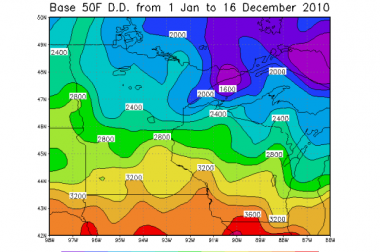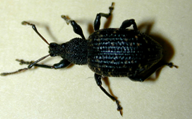
Indicator plants are not always suitable for the timing of pest management practices. You may not have the critical indicator plant nearby to time local activities, or there may not be a good indicator plant for a particular pest’s crucial life stage. Another way of achieving the same result is to use degree day calculations.
Degree days (also known as heat units or thermal units) are a way of incorporating both temperature and time into one measurement to quantify the rate of plant or insect development. All plants and insects develop in response to temperature. The warmer the weather, the more quickly they develop, and the cooler the temperature, the slower they develop.
All species have a cutoff temperature below which no development occurs. This base temperature, or developmental threshold, differs depending on the species. As the ambient temperature increases above the threshold, development occurs. The higher the temperature, the faster the rate of development.
The most common developmental threshold is 50°F. This is the temperature at which dormancy is broken in plants and when many insects become active. But there are a number of insects, particularly those that are active early in the spring, that have a lower threshold (38° or 43°F), and many cool-season vegetables such as cole crops and peas have a base temperature of 40°F. The base temperature is often noted as a subscript number following the abbreviation for degree day (e.g., DD50).
Degree days are accumulated whenever the temperature exceeds the predetermined developmental threshold. A certain number of units are added each 24 hour period, depending on how much the temperature is above threshold, to produce a cumulative total of degree days. The mathematics for calculating actual degree days can be very complex (determining the area under the curve for the graph of time vs. temperature), but easy mathematical equations yield approximations satisfactory for practical applications.
The basic procedure for calculating degree days is very simple, and all you need is a maximum/minimum thermometer. Each day, record the high and low temperatures. Determine the average daily temperature by adding the daily high temperature and low temperature together and dividing by two:
Determine Average Daily Temperature
Avg. Daily Temp = (High Temp. + Low Temp.) ÷ 2
Example: Avg. Daily Temp. = (60° +50°) ÷ 2 = 55°
Next, subtract the base temperature from the average daily temperature to get the number of degree days for that day:
Calculate Degree Days per Day
Daily DD50 = Avg. Daily Temp. – Base Temp.
Example: Daily DD50 = 55° – 50° = 5 DD50
If the average degree day value for a given day is less than zero, just record zero, not a negative number.
Finally, to keep track of degree day accumulation, keep a running total of all degree days accumulated from the first of the year. In Wisconsin, we often don’t accumulate many degree days before April 1, so if you wish to take a break from the math from January to April, go ahead.
The equation above is a very rough estimate of degree day accumulation. There is also an upper threshold for development in insects, above which there is no appreciable increase in the rate of development. This is obviously of more concern later in the season than in the spring. To compensate for the reduced growth rate at high temperatures, modified degree days use an upper threshold of 86°F as well as the lower threshold. Whenever the actual temperature is below the base temperature, the base temperature is substituted as the low temperature for the day. Similarly, whenever the daily high is above 86°, 86° is used as the high temperature for the day.
Example of Upper Threshold in Calculations
Daily High = 90° and Daily Low = 45°
Avg. Daily Temp. = (86° + 50°) = 68°
Daily DD50 = 68° – 50° = 18 DD50
Author: Karen Delahaut, UW-Madison Fresh Market Vegetable Program
Revised: 8/6/2012
Item number: XHT1086
Download Article





 Phenology
Phenology Degree Days for Common Landscape Insect Pests
Degree Days for Common Landscape Insect Pests Degree Days for Common Fruit & Vegetable Insect Pests
Degree Days for Common Fruit & Vegetable Insect Pests Biological Control of Insects and Mites: An Introduction to Beneficial Natural Enemies and Their Use in Pest Management
Biological Control of Insects and Mites: An Introduction to Beneficial Natural Enemies and Their Use in Pest Management


